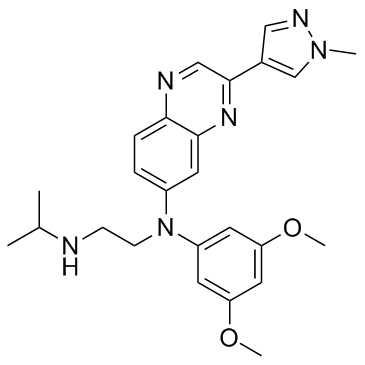1346242-81-6
| Name | N-(3,5-dimethoxyphenyl)-N'-(1-methylethyl)-N-[3-(1-methyl-1H-pyrazol-4-yl)quinoxalin-6-yl]ethane-1,2-diamine |
|---|---|
| Synonyms |
JNJ-42756493
UNII:890E37NHMV 1,2-Ethanediamine, N-(3,5-dimethoxyphenyl)-N-(1-methylethyl)-N-[3-(1-methyl-1H-pyrazol-4-yl)-6-quinoxalinyl]- N-(3,5-Dimethoxyphenyl)-N'-isopropyl-N-[3-(1-methyl-1H-pyrazol-4-yl)-6-quinoxalinyl]-1,2-ethanediamine N1-(3,5-dimethoxyphenyl)-N1-[3-(1-methyl-1H-pyrazol-4-yl)quinoxalin-6-yl]-N2-(propan-2-yl)ethane-1,2-diamine erdafitinib N-(3,5-dimethoxyphenyl)-N'-(1-methylethyl)-N-[3-(1-methyl-1H-pyrazol-4-yl)quinoxalin-6-yl]ethane-1,2-diamine |
| Description | Erdafitinib (JNJ-42756493) is a potent and orally available FGFR family inhibitor; inhibits FGFR1/2/3/4 with IC50s of 1.2, 2.5, 3.0 and 5.7 nM, respectively. |
|---|---|
| Related Catalog | |
| Target |
IC50: 1.2 nM (FGFR1), 2.5 nM (FGFR2), 3.0 nM (FGFR3)and 5.7 nM (FGFR4)[1] |
| In Vitro | Erdafitinib inhibits the tyrosine kinase activities of FGFR1-4 in time-resolved fluorescence assays with IC50 values of 1.2, 2.5, 3.0 and 5.7 nM, respectively. The closely related VEGFR2 kinase is less potently inhibited (30-fold less potent compared to FGFR1) by erdafitinib, with an IC50 value of 36.8 nM. JNJ-42756493 binds FGFR1, 3, 4, and 2 with Kd values of 0.24, 1.1, 1.4 and 2.2 nM, respectively. The Kd value for VEGFR2 is higher at 6.6 nM. JNJ-42756493 inhibits proliferation of FGFR1, 3, and 4 expressing cells with IC50 values of 22.1, 13.2, and 25nM, respectively[1]. |
| In Vivo | In xenografts from human tumor cell lines or patient-derived tumor tissue with activating FGFR alterations, Erdafitinib administration results in potent and dose-dependent antitumor activity accompanied by pharmacodynamic modulation of phospho-FGFR and phospho-ERK in tumors[1]. |
| Cell Assay | Erdafitinib is dissolved in DMSO. KATO III, RT-112, A-204, RT-4, DMS-114, A-427 and MDA-MB-453 cells are treated with erdafitinib (from 10 μM to 0.01 nM in 2% DMSO, final concentration). Following 4-day incubation, cell viability is determined using MTT reagent. The optical density is determined at 540 nm[1]. |
| Animal Admin | Mice: Mice bearing SNU-16 human gastric carcinoma (FGFR2 amplified) xenograft tumors are dosed orally with 0, 3, 10 or 30mg/kg JNJ-42756493. Tumor tissue and mouse plasma (3 mice per time point) are harvested at 0.5, 1, 3, 7, 16 and 24h post-dosing[1]. |
| References |
| Density | 1.2±0.1 g/cm3 |
|---|---|
| Boiling Point | 662.3±55.0 °C at 760 mmHg |
| Molecular Formula | C25H30N6O2 |
| Molecular Weight | 446.545 |
| Flash Point | 354.4±31.5 °C |
| Exact Mass | 446.243011 |
| PSA | 77.33000 |
| LogP | 3.60 |
| Vapour Pressure | 0.0±2.0 mmHg at 25°C |
| Index of Refraction | 1.618 |
| Storage condition | -20℃ |
